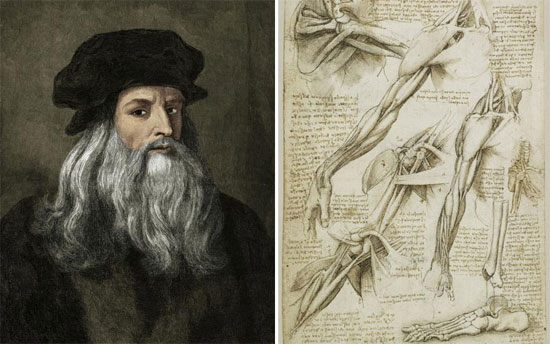Leonardo da Vinci: Anatomy scientist
Leonardo da Vinci is famous for its unique and priceless paintings in the world. However, he is also known for his elaborate, rare and extremely precise anatomical drawings at that time.
18 drawings in his collection of more than 240 anatomy paintings were gathered and displayed at Holyrood Palace in Edinburgh. This is also the first time such a large number of anatomical paintings of talented artists have been introduced to the public.
Beginning in 1507, after a conversation with an old man who was about to take his last breath on a hospital bed, the painter came up with an idea to find out what in the body created death, life . through surgery can. He once confessed in some notes that he was obsessed with human body structures. The artist himself performed about 30 such surgeries on the body, and recorded with extremely precise and precise sketches. About 240 such sketches were formed, along with a specific description of a total of about 13,000 words in length.

Portrait of Leonardo da Vinci along with the outline of muscles and human bones
The organizer of the show, Martin Clayton, commented: 'They are the best illustrations, especially compared to today's anatomy.' The special thing of this exhibition is that the sketches of the painting are displayed simultaneously with scans, tomography with modern devices today, to compare and see the ability to describe extremely important body of Leonardo da Vinci.
Earlier, from the late 1480s, Leonardo began to pay attention to human anatomy. His 44-page booklet in 1489 has some very beautiful human skull drawings. But around the time, the artist was distracted by other concerns, and he felt inadequate to do it. He received a large mural painting, including 'Last Supper', 'Battle of Anghiari'.
The interest in anatomy draws back to the painter around 1504. Clayton analyzed: 'He always wanted to learn deeply about the human body, initially the surface muscle layer, and then the muscle layers. inside out. These things bring him back to the anatomical studies' . At this time, with his prestige and name, Leonardo has absolutely conditions to conduct autopsy, usually of executed criminals. Clayton commented: 'In the last 12 years of his life, he moved from a painter to a scientist, but he did research work with his great artistic talent'.
The paintings on display at the Edinburgh Palace date back to 1510-1511, when Leonardo collaborated with anatomists Verona at the medical school of Pavia University (Milan). During the Renaissance, many considered anatomy to be scary, even illegal, involving necromancy. Some even argue that the body dissection is contrary to Church regulations. However, in the 15th and 16th centuries, the anatomy was viewed differently, more respected, and there was no problem with the Church. That was the time when the anatomy industry boomed.
Although not Leonardo was the only painter interested in anatomy at the time, however, what made his research different from all others was the precise and meticulous descriptions passed. sharp and delicate observation. Clayton said: 'Leonardo pays special attention to the role and operation of the heart valve, he even built a heart valve model that simulates the heart's pumping action. This is something we never knew until the 20th century, which the artist studied and did since 1513 '.
Martin Clayton's intention is to focus and visual techniques in Leonardo's drawings. Clayton described, Leonardo used rules in architecture and engineering to describe human body structures, so his drawings became vivid, subtle and very accurate.'Only today, with the help of computers, can we see the extraordinary efforts of the artist' , Clayton said.

Sketch of human skull
The tragedy for these drawings is that Leonardo never published them. The sudden death of plague of close colleague Marcantonio della Torre in 1511, along with political instability and the French occupation of Milan in 1499, made the talented artist very difficult to complete the project. me He retired to the residence of the student and secretary Francesco Melzi 15 miles from Milan (more than 30km).
With the time and data collected in each of these years, Leonardo should have been able to complete his research, but instead, he took the time to draw landscapes, design and research embryos. , heart valves.
In 1519, when the artist died, about 6,500 papers and documents of his drawings were scattered. In 1690, most of these papers were gathered at the Royal Collection Room, however they were not analyzed and systematically re-dated until the end of the 19th century. That is why the studies exceeded His time could not affect medicine or science.
Clayton said: 'We only made the final part of him: publishing parts of anatomy drawings in part. Leonardo pushed the understanding of the human body further than anyone else in the Renaissance. '
- Scientists want to rebuild Leonardo da Vinci's genome
- Discover the secret talent of the great Leonardo da Vinci
- Errors in the famous picture of Leonardo da Vinci
- Leonardo Da Vinci bought a skull?
- Leonardo da Vinci and secrets not everyone knows
- Find out the descendant of the life of Leonardo da Vinci
- 4 giant 'treasures' of Leonardo Da Vinci: The solution after 500 hundred years
- Hair fibers are expected to make history after 500 years Leonardo da Vinci died
- Effort to save Leonardo Da Vinci's self-portrait
- Memo book of Leonardo Da Vinci
- Revealing the portrait of Leonardo da Vinci through an ancient 500-year-old painting
- Leonardo da Vinci has a sharp artistic eye due to vision problems
 The most famous scientific failures in history
The most famous scientific failures in history Mysterious genius mechanic and the machine froze time
Mysterious genius mechanic and the machine froze time The son carries the 'bad gene' of genius Albert Einstein
The son carries the 'bad gene' of genius Albert Einstein Isaac Newton
Isaac Newton